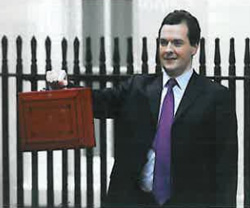

 Budget 2011
Budget 2011
George Osborne, delivered the 2011 Budget on 23 March 2011 and we look at the main provisions, some of which were announced previously and confirmed in the Budget.
Income Tax Rates and Allowances
Allowances:
|
Personal allowance |
6,475 |
7,475 |
|
Age allowance (65 – 74) |
9,490 |
9,940 |
|
Age allowance (> 75) |
9,640 |
10,090 |
|
Married couple’s allowance |
6,965 |
7,295 |
|
Age-related allowance income limit |
22,900 |
24,000 |
The personal allowance will be increased to £8,105 in 2012/13.
Tax rates:
|
Basic rate – 20% |
0 – £37,400 |
0 – £35,000 |
|
Higher rate – 40% |
£37,401 – £150,000 |
£35,001 – £150,000 |
|
Top rate – 50% |
Over £150,000 |
Over £150,000 |
The basic rate band will reduce to £34,370 in 2012/13. Other rates and allowances will be increased by the rate in the RPI.
Savings and investments
Pension contributions:
The Annual Allowance for tax relief on pension contributions is reduced from £255,000 to £50,000 from 5 April 2011 and the Lifetime Limit is reduced from £1.8 million to £1.5 million from 5 April 2012. Members of registered schemes will be able to carry forward unused Annual Allowance for up to three years.
Furnished holiday lettings:
The current rules on furnished holiday lettings have been preserved although with some restrictions:
- To qualify as a furnished holiday letting, from April 2012, the property must be available for letting for at least 201 days per annum and actually let for at least 105 days
- From April 2011, losses on FHLs will not be available to offset against other income.
Enterprise Investment Scheme:
From 6 April 2011, the rate of tax reducer relief for EIS investments will increase to 30% of the investment and from 6 April 2012, the investment limit for EIS shares will increase to £1 million per annum. The same increases will apply to investment in Venture Capital Trusts.
There are also changes designed to increase the number of companies which can take advantage of the scheme:
- The number of employees a qualifying company can have will rise from 59 to 250
- The size limit for a qualifying company will rise from £7 million to £15 million
- Maximum annual investment will rise from £2 million to £10 million
ISAs
From 6 April 2011, the limit increases to £10,680, with the cash limit increasing from £5,100 to £5,340.
Businesses and Employers
Corporation tax:
From 1 April 2011, the main rate of corporation tax will drop to 26%, with further falls to 25% from 1 April 2012, and to 24% and 23% in the following two years. The small company rate reduces to 20% from 1 April 2011.
National Insurance:
The much-discussed rise in National Insurance Contributions goes ahead from 6 April 2011:
Class 1 for employees: 12% (up from 11%) on earnings of £139 – £817 per week and at 2% (up from 1%) thereafter
Class 1 for employers: 13.8% (up from 12.8%) on earnings over £136 per week
The Chancellor announced consultation on merging income tax and national insurance as a way to reduce the administrative burden on employers, although any changes are likely to be a long way off.
Capital allowances:
Capital allowances are to be reduced from April 2012 – the 20% writing-down allowance becomes 18% and the 10% rate which applies to certain assets (most notably high-emission cars) reduces to 8%.
The Annual Investment Allowance, which provides 100% tax relief on expenditure will be reduced from April 2012 from £100,000 per annum to just £25,000.
A short-life asset election will be available from April 2011 onwards for any asset with an anticipated life of up to 8 years
Research and development expenditure:
The current 175% relief for qualifying R&D expenditure by small/medium-sized enterprises will become 200% from 1 April 2011 and then 225% from 1 April 2012. The minimum expenditure limit of £10,000 is abolished, enabling companies to claim for smaller amounts.
Approved mileage rate and company cars:
Currently employees may be paid a tax-free mileage allowance of up to 40p per mile for the first 10,000 miles and up to 25p thereafter for using their own car for business purposes. The 40p allowance rises to 45p per mile from 6 April 2011, although the 25p rate remains.
Company car and fuel benefits:
The percentages and CO2 emission bands used to calculate the benefit are adjusted slightly and fuel benefit rises to £18,800 multiplied by the percentage appropriate to the car concerned.
Capital Gains Tax and Inheritance Tax
The CGT annual exemption rises from £10,100 to £10,600 from 6 April 2011; the cumulative lifetime limit for entrepreneur’s relief for gains on the sale of businesses increases from £5 million to £10 million.
The nil-rate band for IHT remains frozen at £325,000 until 2014/15 but will be increased from 2015/16 in line with the Consumer Prices Index.
VAT
Registration and deregistration limits increase to £73,000 and £71,000 respectively. The rate of VAT remains unchanged.
Krystyna Knight, of Silver Levene provided research for this article.
Disclaimer
Umesh Modi BA ACA, is a Chartered Accountant and Tax Advisor, and a partner at Silver Levene (Incorporating Modiplus+). He can be contacted on 020 7383 3200 or umesh.modi@silverlevene.co.uk

